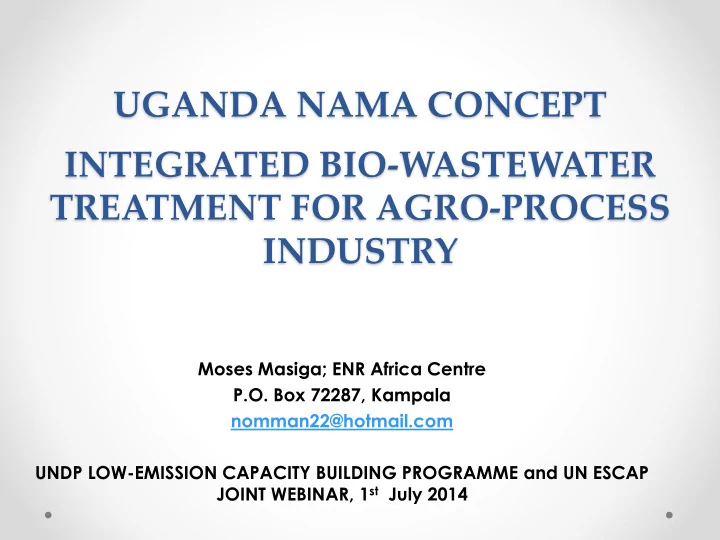

UGANDA NAMA CONCEPT INTEGRATED BIO-WASTEWATER TREATMENT FOR AGRO-PROCESS INDUSTRY Moses Masiga; ENR Africa Centre P.O. Box 72287, Kampala nomman22@hotmail.com UNDP LOW-EMISSION CAPACITY BUILDING PROGRAMME and UN ESCAP JOINT WEBINAR, 1 st July 2014
PRESENTATION • Introduction and rationale for NAMA • NAMA Policy focus • Technology proposed for NAMA & potential benefits • Next steps in developing MRV strategy
INTRODUCTION & RATIONALE Uganda government considers pollution from wastewater • as a major urban environment management problem. Less than 1/3rd of industries & factories have wastewater • treatment facilities or discharge permits. Even though compliance was dominated by low cost • aerobic systems, compliance is low and a lot of CO 2 released too. Proposed anaerobic - aerobic systems are relatively • expensive, but offer a lot of value added benefits, & further reduce pollution load in wastewater & GHG emissions reductions. Therefore, a solution that augments current laws is justified. •
NAMA POLICY FOCUS Target regulation & policy • • Water (Waste Discharge) Regulations S.I. 152-4, under the Water Act Cap 152. • The National Environment (Standards for Discharge of Effluent into Water or on Land) Regulations 1999. • National Climate Change Policy & Strategic Plan 2014 Target industries • • Fish factories, abattoirs, beverage companies, • Vegetable oil processors • Sewage and other urban centre waste water flows
ACTION: Anaerobic-Aerobic Sequence Bio-Reactor (SBR) Raw effluent from processing Sludge dewatering facility Stack gas for cooking & lighting Gas engine for power generation Aerobic digester tank Anaerobic digester System (Sequencing Batch Reactor, SBR tank system Power for the project activity Sludge for Constructed wetland bio-fertiliser Project boundary Effluent discharge
BENEFITS OF UNDERTAKING NAMA Value-addition Benefits from technology • Renewable energy - biogas for • Methane captured & some CO 2 is electricity generation & released from energy generation • Biogas for cooking • Bio-fertiliser (also under aerobic • But methane has a global digester) warming potential 21 times higher than CO 2 . • Proposals on CDM PoA & NAMA • Reducing wastewater pollution flow into freshwater systems and on land Policy/ regulatory benefits Incentives for industries and to comply with regulations wastewater discharge with a cost-effective technology
MRV: KEY INFORMATION REQUIREMENTS Key Objectives Information needed to provide a response? Wastewater generated & treatment Baseline – amount of GHG processes emissions generated through Electricity consumed under current current processes wastewater treatment systems Improved wastewater No. of improved wastewater treatment processes processes introduced Methane emissions reductions as a result Reduction in GHG emissions of improved processes Reduction in water pollution Contribution to Uganda’s Generation of renewable electricity sustainable development Employment creation Funds mobilised Efficient management and Resources allocated accountability of NAMA Activities performed programme Reductions in GHG emissions achieved
MRV: NEXT STEPS Barrier Next steps Institutional Propose a strategic MRV framework Integrating NAMA into sector work plans, strategic plans Review regulatory framework Integrate NAMAs wastewater into sector performance targets Capacity Outline capacity needs for training of trainers Design training programme & support to implement Cooperation among institutions to fill gaps Information Elaborate data requirements to support collection processes Description of Targets: Urban authorities, NEMA, DWRM, private sector data Financial Develop Resource Mobilization Strategy Sources of financing: (a) Private sector; (b) Government fiscal instruments; and (c) Development partners
Thanks
Recommend
More recommend